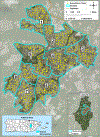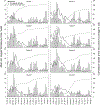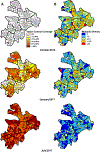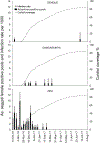Citywide Control of Aedes aegypti (Diptera: Culicidae) during the 2016 Zika Epidemic by Integrating Community Awareness, Education, Source Reduction, Larvicides, and Mass Mosquito Trapping
- PMID: 30753539
- PMCID: PMC6597296
- DOI: 10.1093/jme/tjz009
Citywide Control of Aedes aegypti (Diptera: Culicidae) during the 2016 Zika Epidemic by Integrating Community Awareness, Education, Source Reduction, Larvicides, and Mass Mosquito Trapping
Abstract
This investigation was initiated to control Aedes aegypti and Zika virus transmission in Caguas City, Puerto Rico, during the 2016 epidemic using Integrated Vector Management (IVM), which included community awareness and education, source reduction, larviciding, and mass-trapping with autocidal gravid ovitraps (AGO). The epidemic peaked in August to October 2016 and waned after April 2017. There was a preintervention period in October/November 2016 and IVM lasted until August 2017. The area under treatment (23.1 km2) had 61,511 inhabitants and 25,363 buildings. The city was divided into eight even clusters and treated following a cluster randomized stepped-wedge design. We analyzed pools of female Ae. aegypti adults for RNA detection of dengue (DENV), chikungunya (CHIKV), and Zika (ZIKV) viruses using 360 surveillance AGO traps every week. Rainfall, temperature, and relative humidity were monitored in each cluster. Mosquito density significantly changed (generalized linear mixed model; F8, 14,588 = 296; P < 0.001) from 8.0 ± 0.1 females per trap per week before the intervention to 2.1 ± 0.04 after the percentage of buildings treated with traps was 60% and to 1.4 ± 0.04 when coverage was above 80%. Out of a total 12,081 mosquito pools, there were 1 DENV-, 7 CHIKV-, and 49 ZIKV-positive pools from October 2016 to March 2017. Afterward, we found only one positive pool of DENV in July 2017. This investigation demonstrated that it was possible to scale up effective Ae. aegypti control to a medium-size city through IVM that included mass trapping of gravid Ae. aegypti females.
Keywords: Aedes aegypti; AGO traps; Zika virus; mosquito control; vector-borne pathogen.
Published by Oxford University Press on behalf of Entomological Society of America 2019.
Figures








References
-
- Amarakoom D, Chen A, Rawlins S, Chadee DD, Taylor M, and Stennett R. 2008. Dengue epidemics in the Caribbean-temperature indices to gauge the potential for onset of dengue. Mitigation Adapt. Strateg. Glob. Chang. 13: 341–357.
-
- Barrera R 2010. Dinamica del dengue y Aedes aegypti in Puerto Rico. Biomedica 21: 179–195.
-
- Barrera R 2015. Considerations for disrupting dengue virus transmission: ecology of Aedes aegypti and current (non genetic) methods of control, pp. 103–124. In Adelman ZN (ed.), Genetic control of malaria and dengue. Academic Press, Oxford.
MeSH terms
Substances
Grants and funding
LinkOut - more resources
Full Text Sources
Medical
Miscellaneous

